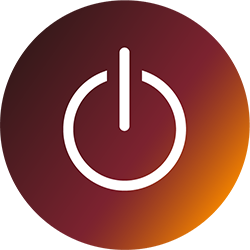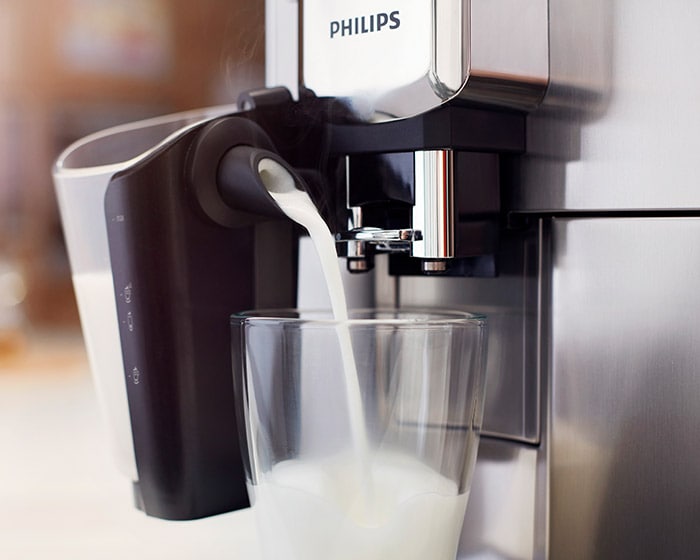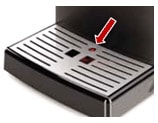How to troubleshoot my Philips Espresso machine?
Below you will find a selection of the most frequently asked questions. All solutions and support movies are applicable for the complete range of Philips full automatic espresso machines, such as the Philips 5000 LatteGo, Philips 5000 series, Philips 4000 series, Philips 3000 series, Philips 2100 series and Philips 2000 series.
Please select the type of issue to find your solutions











LatteGo
Some frequently asked questions about our LatteGo milk system
This may have two causes:
1. You have not assembled the two parts of the LatteGo correctly
Milk may leak from the hole in the bottom of your Philips LatteGo milk frother when you have not assembled the two parts properly. Connect the two parts to each other until you hear a **click**. Please note that this may require some force.
2. You did not remove the transport clip of the LatteGo.
When you unpack LatteGo, you have to remove the transport clip before you can use your milk frother.
The small hole in the bottom lets the milk flow into the frothing chamber through the channel that is created by the milk container and the seal on the LatteGo frame.
It is normal that there is some milk left behind in the milk container after use. This is necessary to ensure a perfect frothing result and to prevent air from being drawn in at the end of the frothing process.
If the amount of milk left behind in the milk container is larger than usual, please check the following.
1. Did you adjust the milk length via de memo function?
If you did, you cannot use the indications on the frame as reference because you customized the milk quantity for the drink.
2. If you did not adjust the milk length via de memo function.
There is more milk in the milk container after frothing because you filled the container beyond the required level for the drink. Make sure that you fill the milk container to the required level for one or two cups of cappuccino or latte macchiato.
LatteGo can only be used on the machines it is sold with. It cannot be exchanged with other milk frothing systems.

disappear
I cannot remove the brew group
If you cannot remove the brew group, the machine is not in the neutral position. Follow the steps below in order to be able to remove the brew group.
1. Replace the coffee grounds container and the drip tray and close the service door.
2. Switch the machine off. Wait until it is completely switched off and you hear no more sounds (this can take up to 15-20 seconds).
3. Switch the machine back on. Wait again until it is completely switched on and you hear no more sounds.
4. Remove the coffee grounds container and the drip tray, open the service door and try again to remove the brew group.
Never remove the brew group during descaling. Always finish the descaling process first.
Philips 2200 Series
Philips 2200 Series LatteGo
Philips 3200 Series
Philips 3200 Series LatteGo
Was this information useful?
I cannot insert the brew group
If you cannot insert the brew group, the machine and brew group are not in the neutral position.
Follow the steps below to set the machine and brew group in neutral position:
1. Replace the coffee grounds container and the drip tray. Close the service door, but leave out the brew group.
2. Switch the machine off. Wait until it is completely switched off and you hear no more sounds (this can take up to 15-20 seconds).
3. Switch the machine back on. Wait again until it is completely switched on and you hear no more sounds.
4. Set the brew group to its neutral position. Watch the movie below for instructions.
5. Remove the coffee grounds container and the drip tray, open the service door and try again to insert the brew group.
Philips 2200 Series
Philips 2200 Series LatteGo
Philips 3200 Series
Philips 3200 Series LatteGo
Was this information useful?
Why doesn’t my machine create good milk foam?
If the milk carafe is not frothing the milk, there can be various causes and solutions. Detach all parts of the milk system, including the tubes, and clean them. It is best to use cold milk directly from the refrigerator at a temperature of 4 degrees. Semi-skimmed or full-fat cow's milk, soy milk and lactose-free milk have been tested and proven to give good froth.
1. The parts of the milk system are dirty.
2. The milk tube is not properly connected to the frothing element or cappuccinatore.
Attach the milk tube properly to the frothing element or cappuccinatore.
3. The milk is not cold.
4. You’re not using the correct type of milk.
Was this information useful?
The machine is making a loud noise
Sounds are normal when using your espresso machine. If you hear unusual noises, discover here what could cause this and how to easily resolve it. 4. When using an AquaClean/Brita filter The filter was not prepared properly before installation or might be clogged. Switch off the machine. Remove the filter and try again to brew a coffee. If this works, make sure the filter is prepared properly before placing it back, see movie how to prepare the AquaClean filter. Place back the prepared filter and brew a coffee. If this still does not work the filter might be clogged and needs to be replaced.*The support movie is applicable for all Full Automatic Espresso machines, not only the mentioned models.
Loud noise during grinding might be caused by:
1. A blocked coffee funnel.
Unblocking the coffee funnel might solve the problem. Follow the steps in the support movie* how to clean.
2. The grind setting is set to the finest grind.
Adjust the grind setting to a courser grind. Follow the steps in the support movie* first time use and how to customize settings.
Loud noise during rinsing or brewing might be caused by:
1. Coffee beans/particles trapped under the water tank and air is drawn
Remove the water tank and remove any beans/bean particles located in the water tank compartment area. Follow the steps in the support movie* how to clean.
2. The brew group is clogged by dirt or not well greased
Remove the brew group and rinse it under the tap, grease if needed. Follow the steps in the support movie* how to clean for cleaning instructions and how to insert and remove the brew group.
3. The machine needs to be descaled.
If you have not descaled the machine in a while or postponed it a few times, it is now time to descale the machine. Only descale the machine with the Philips/Saeco decalcifier. On the descaling page you can find the correct instructions for your machine.
Was this information useful?
Service key error code 1, 3, 4, 5, 14 or 19 appears in the display
When error code 1, 3, 4, 5 or 14 is shown on the display, check the solutions below.
If any other code appears, we advise you to contact our Consumer Care Center for assistance
E01 The coffee funnel is blocked by ground coffee. 1. Take out the brew group and clean the coffee funnel with a spoon handle. 2. If there is no pre-ground coffee funnel, insert the spoon handle into the coffee funnel from below.
To unblock the coffee funnel;


E03 The brew group is clogged or has not been properly greased. 1. Rinse the brew group with fresh water, paying particular attention to the filter. 2.Grease the brew group as described in the cleaning and maintenance section.
E04 The brew group is clogged, has not been properly greased or is not locked in position. 1.Rinse the brew group with fresh water, paying particular attention to the filter.
2. Grease the brew group as described in the cleaning and maintenance section.
3. Replace the brew group and make sure it is locked into place. You hear a soft click when it is correctly inserted and locked.
4.Switch the machine off and back on.
E05 As there can be multiple causes, please contact our Consumer Care Center for assistance.
E14
Error code 1 support movie
Error code 3/4 support movie
Error code 5 support movie
Was this information useful?
The ‘empty coffee grounds container’ message does not disappear
If the coffee grounds container is emptied while the machine is switched off, the coffee cycle counter is not reset and the ‘empty coffee grounds container’ message does not disappear.
To make the message disappear:
• Remove the coffee grounds container while the machine is switched on, wait at least 5 seconds and then reinsert it.
Was this information useful?
The descaling light does not go off after descaling
If the descaling light is still on then most probably you have not rinsed the machine with sufficient water after the descaling cycle was completed. Rinse your machine using another full tank of water.
If you stopped the descaling procedure by switching off your machine and you don’t know how to resume, please contact our Consumer Care Center for assistance.
Was this information useful?
I don’t understand the meaning of the light signals on my espresso machine
The lights on your espresso machine give you information on what to do as well as on the status of your machine.
The user manual contains a dedicated chapter on the meaning of the lights. Use this search function below to locate and download the appropriate user manual for your Philips or Saeco espresso machine.
Note: If all lights are blinking simultaneously, please contact our Consumer Care Centre for assistance.
Search by product number.
We found {number} products that are available outside your country, so local promotions may not apply.
Show productsFound {number} products
Found your model, but...
This product is not available in your country, but we found one in another country
Please select your model based on the last 2 digits of your product number shown in blue.
Found your model!
foundation-catalog.se01c-prx-search.search-sub-heading7
foundation-catalog.se01c-prx-search.search-sub-heading8
If this is the correct one, please select it below. Otherwise, search again.
Product image
Product description
Model number
Was this information useful?
The coffee machine brews watery coffee
If the coffee is getting watery, there can be various causes and solutions.
• The Saeco adapting system is still adjusting. Brew a few more cups of coffee.
• Rinse the brew group with fresh water, especially the filter on the brew group.
• Grease the brew group as described in Cleaning and Maintenance chapter
• Take out the brew group and clean the coffee funnel with a spoon handle.
• If there is no pre-ground coffee funnel, insert the spoon handle into the coffee funnel.


How to rinse the brew group
How to unblock the coffee funnel
Was this information useful?
Only a few drops of coffee are being dispensed
If only a few drops of coffee are being dispensed, there can be various causes and solutions.
• Rinse the brew group with fresh water, paying particular attention to the filter.
• Grease the brew group as described in the cleaning and maintenance section.
• Clean the coffee spout with a needle.
• Remove the filter from the water tank and immerse it upside down in water.
• Replace the filter and dispense 2-3 cups of hot water.
• If the problem still persists, make a coffee without using the filter. If this works, you know that your filter is clogged and needs to be replaced.
• Descale the machine with the Philips/Saeco decalcifier.
How to rinse the brew group
How to grease the brew group
How to prepare the AquaClean filter
Was this information useful?
No coffee or water is being dispensed
As there can be different causes, one of the following solutions might work for you. The support movie* shows more detailed instructions.
1. During first time use
It is normal that the first brewed cups can be watery as the Saeco adapting system is still adjusting. Brew 5-7 more cups of coffee.
2. Coffee beans/particles trapped under the water tank and air is drawn
Remove the water tank and remove any beans/bean particles located in the water tank compartment area. Follow the steps in the support movie* how to clean.
3. The brew group is clogged by dirt
Remove the brew group and rinse it under the tap, grease if needed. Follow the steps in the support movie* how to clean for cleaning instructions and how to insert and remove the brew group.
4. When using an AquaClean/Brita filter.
The filter was not prepared properly before installation or might be clogged.
Remove the filter and try again to brew a coffee. If this works, make sure the filter is prepared properly before placing it back, see movie how to prepair the AquaClean filter. Place back the prepared filter and brew a coffee. If this still does not work the filter might be clogged and needs to be replaced.
5. There is air in the water circuit
Try to dispense 2-3 cups of hot water.
6. For Exprelia or Xelsis machines.
The SBS knob is closed. Turn the SBS knob to the middle position and brew an espresso.
7. The machine needs to be descaled.
If you have not descaled the machine in a while or postponed it a few times, it is now time to descale the machine. Only descale the machine with the Philips/Saeco decalcifier. On the descaling page you can find the correct instructions for your machine.
*The support movie is applicable for all Full Automatic Espresso machines, not only the mentioned models.
Was this information useful?
The machine seems to be leaking
Your drip tray is probably full, and water is therefore flowing over.
Empty your drip tray regularly; the ‘drip tray full’ indicator tells you when to do so.

Was this information useful?
The machine is not grinding the coffee beans
The coffee funnel is blocked by ground coffee. To unblock the coffee funnel;
• Remove the brew group and clean the coffee funnel with a spoon handle.
• If there is no pre-ground coffee funnel, insert the spoon handle into the coffee funnel from below.
• If you have a Moltio or GranBaristo machine with a removable bean container, remove this container and disassemble. Remove any beans that are stuck in the two separate parts.


Support movie
Was this information useful?
The machine will not switch on
If your espresso machine does not switch on when you press the power button, there can be various causes and solutions. 1. Check the power cord and switch on the back 2. Connect to an another power socket Check if there are too many appliances connected to the power supply group. Try to connect the machine to another power socket.
Was this information useful?
You are about to visit a Philips global content page
ContinueSearch by the name or product number of your Saeco or Philips espresso machine
More detailed information on how to solve your troubleshooting with your Saeco and Philips espresso machine is only a couple of clicks away.
Search by product number.
We found {number} products that are available outside your country, so local promotions may not apply.
Show productsFound {number} products
Found your model, but...
This product is not available in your country, but we found one in another country
Please select your model based on the last 2 digits of your product number shown in blue.
Found your model!
foundation-catalog.se01c-prx-search.search-sub-heading7
foundation-catalog.se01c-prx-search.search-sub-heading8
If this is the correct one, please select it below. Otherwise, search again.
